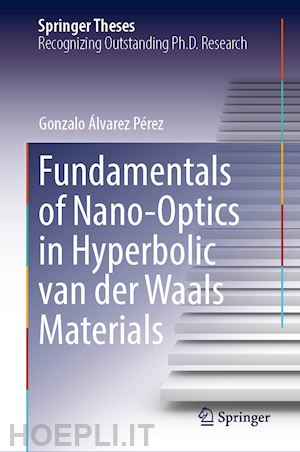
Questo prodotto usufruisce delle SPEDIZIONI GRATIS
selezionando l'opzione Corriere Veloce in fase di ordine.
Pagabile anche con Carta della cultura giovani e del merito, 18App Bonus Cultura e Carta del Docente
This thesis focuses on the study of phonon polaritons—hybrids of infrared light and lattice vibrations—in van der Waals polar materials, particularly strongly anisotropic (hyperbolic) ones. It combines experiments, analytical theory, and numerical simulations to explore nanoscale optical phenomena that challenge our conventional understanding, such as negative reflection, anomalous refraction and polariton canalization. These studies have paved the way for practical applications in integrated flat optics, such as planar lenses and resonators for nanoscale light. The thesis also introduces the emerging field of twistoptics, aimed at controlling the propagation of light at the nanoscale by stacking slabs of van der Waals materials at different rotation angles, and introduces innovative approaches to tune polariton properties both passively and actively. In addition to providing a solid foundation for future advancements in planar nano-optical devices and helping lay the fundamentals of light-matter interactions in hyperbolic van der Waals materials, the thesis's didactic approach makes complex phenomena accessible to a broad audience.
Part 1: Introduction.- Chapter 1: Introduction To Nanoscale-Confined Propagating Polaritons.- Chapter 2: Experimental and Modelling Techniques.- Part 2 - Enabling Predictive Capabilities For Hyperbolic
Polaritons In Van Der Waals Materials.- Chapter 3: Dispersion of Polaritons In Biaxial Slabs.- Chapter 4: Infrared Permittivity Of -Moo3 From Near- And Far-Field Correlative Studies.- Part 3 - Anomalous Optical Phenomena At The Nanoscale In Strongly Anisotropic Media.- Chapter 5: Negative Reflection of Nanoscale-Confined Hyperbolic Polaritons.- Chapter 6: Anomalous Refraction And Lensing of Nanoscale- Confined Hyperbolic Polaritons.- Part 4 - Controlling, Directing And Guiding Hyperbolic Polaritons At The Nanoscale.- Chapter 7: Enabling Propagation of Hyperbolic Polaritons Along Forbidden Directions.- Chapter 8: Twist-Optics: Controlling The Propagation of Phonon Polaritons With Twisted Van Der Waals Stacks.- Chapter 9: Active Tuning of Hyperbolic Polaritons In Van Der Waals Materials By Integrating A Gated Graphene Layer.- Chapter 10: Twistable Polaritonics With In-Operando Rotatable Van Der Waals Bilayers.- Chapter 11: Conclusions and Outlook.
Gonzalo Álvarez-Pérez obtained his BScs in Physics and Mathematics from University of Oviedo in 2017 and his MSc in Big Data Analytics from Carlos III University of Madrid in 2018. He earned a second MSc in Nanoscience from the University of the Basque Country that same year, conducting his Master’s Thesis in Prof. Rainer Hillenbrand’s group under the supervision of Dr. Alexey Nikitin and Dr. Pablo Alonso-González. In January 2024, he completed his PhD in Condensed Matter Physics, Nanoscience, and Biophysics at University of Oviedo, graduating cum laude, again under the guidance of Dr. Alonso-González and Dr. Nikitin. Gonzalo's PhD work, published here, focused on the interaction between infrared light and hyperbolic van der Waals materials. He has been recognized with numerous honors and scholarships throughout his academic career, including a Fulbright fellowship for predoctoral research at Columbia University in Prof. Dmitri Basov’s group. He also undertook a short stay in Dr. Alexander Paarmann’s group at the Fritz Haber Institute of the Max Planck Society. Currently, he is a postdoctoral researcher in the Computational Nanoplasmonics unit at the Italian Institute of Technology, led by Dr. Cristian Ciracì. Gonzalo’s research has yielded more than 20 peer-reviewed articles in renowned journals, such as the Nature, Science, APS, and ACS families, three of them chosen by the Spanish Royal Physical Society in their biannual call for best papers. He has delivered numerous invited and contributed talks at international conferences, His talks in both 2020 and 2021 in the largest European conference in graphene and 2D materials were chosen among the best talks by PhD students. Additionally, he has co-founded a student chapter at University of Oviedo to promote networking between early career researchers in optics and photonics. He also co-founded a non-profit organization to advocate for equality and social justice through cultural events, supporting marginalized groups and raising funds for charities through art exhibitions.











Il sito utilizza cookie ed altri strumenti di tracciamento che raccolgono informazioni dal dispositivo dell’utente. Oltre ai cookie tecnici ed analitici aggregati, strettamente necessari per il funzionamento di questo sito web, previo consenso dell’utente possono essere installati cookie di profilazione e marketing e cookie dei social media. Cliccando su “Accetto tutti i cookie” saranno attivate tutte le categorie di cookie. Per accettare solo deterninate categorie di cookie, cliccare invece su “Impostazioni cookie”. Chiudendo il banner o continuando a navigare saranno installati solo cookie tecnici. Per maggiori dettagli, consultare la Cookie Policy.